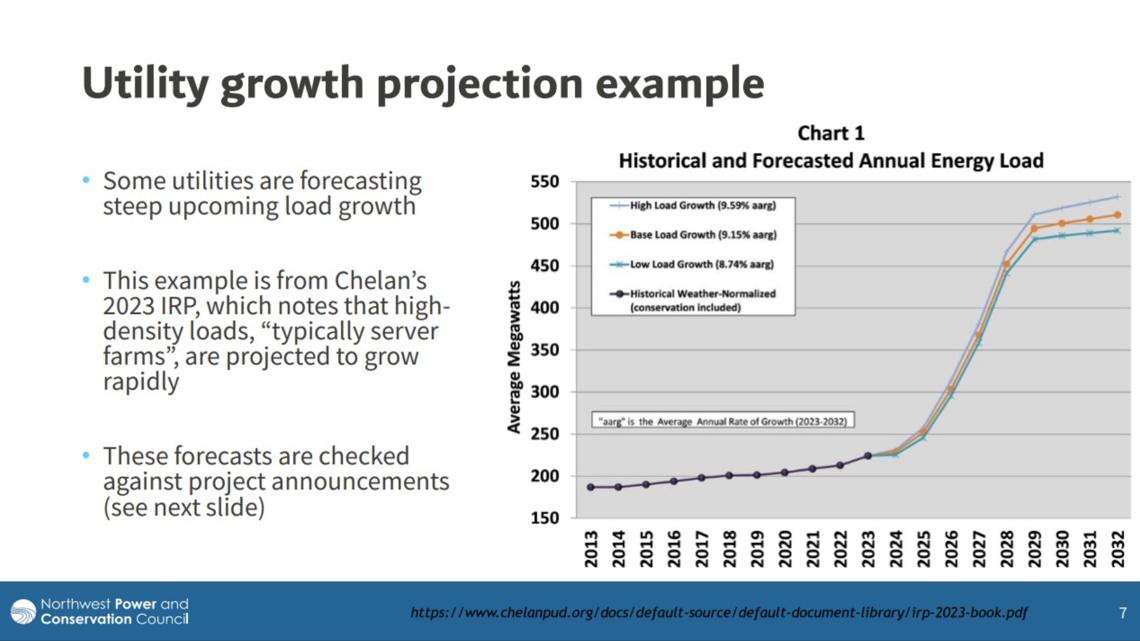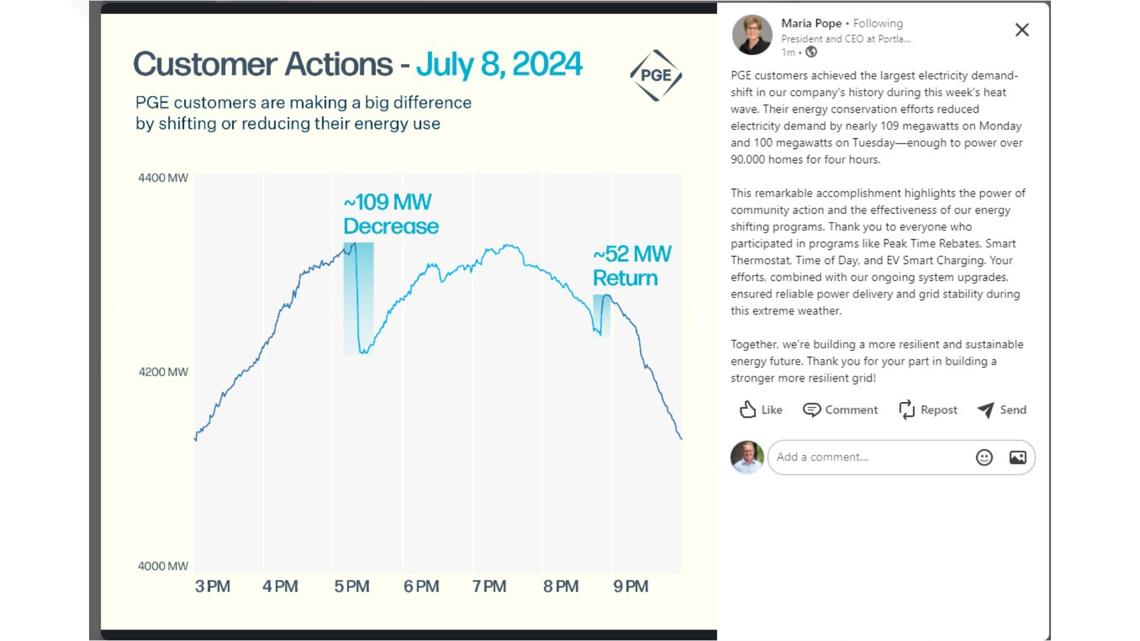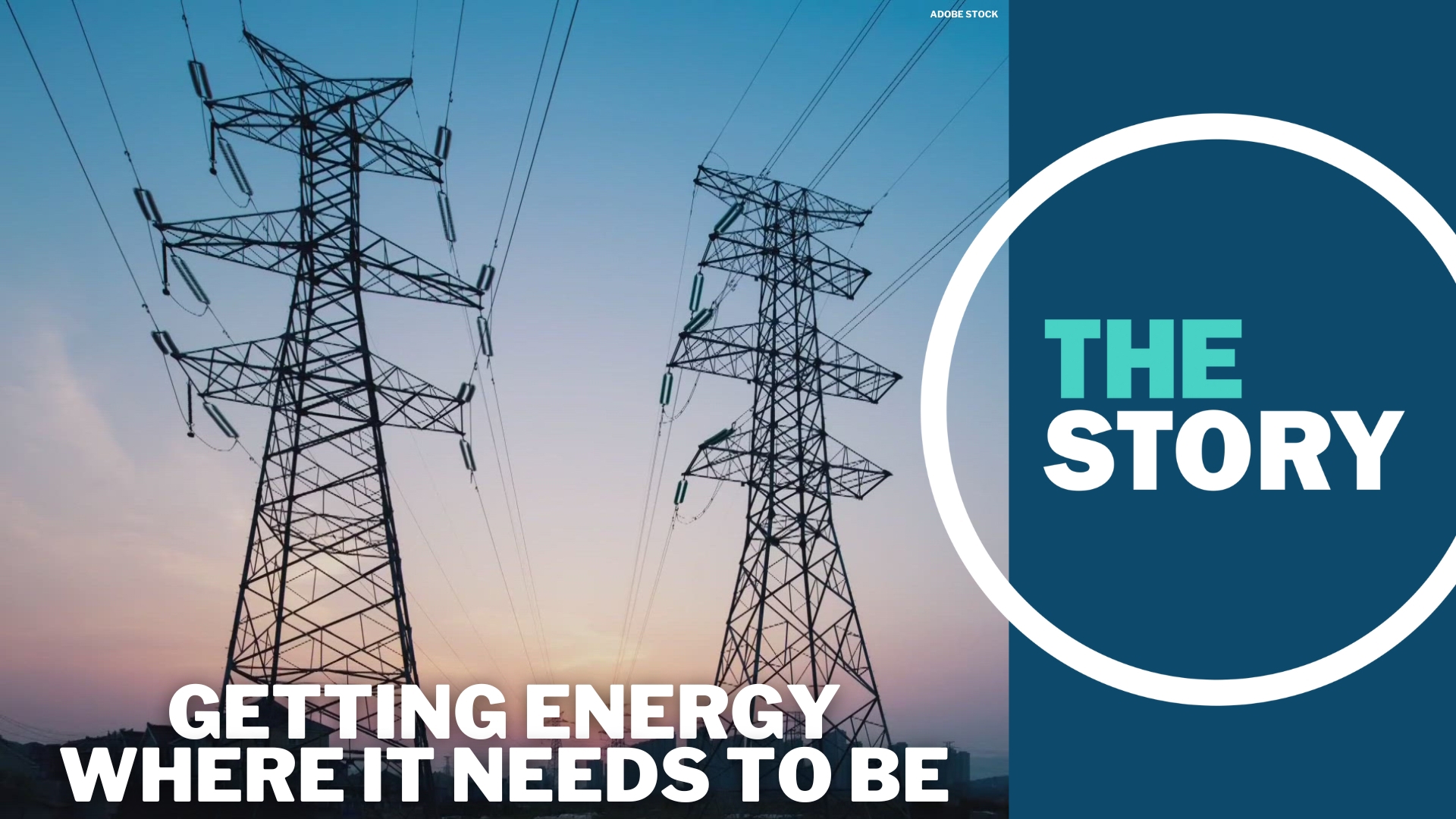PORTLAND, Ore. — Across the country, many states are trying to transition away from fossil fuels and toward clean methods of energy production. Oregon is no exception, having set goals for power utility companies to reduce greenhouse gas emissions from electricity sold in Oregon to 100% below baseline by 2040.
The Northwest Power and Conservation Council reports that the region will use about 22,000 average annual megawatts in 2024. One megawatt can power 796 homes in the Northwest, meaning about 17.5 million homes could be powered in 2024.
But it isn't just homes using that power. Increasingly, electricity is also powering electric vehicles and big consumers, like data centers. Those are each forecasted to grow substantially in the next five years.
In a projection from the Chelan Public Utility District offered at a Bonneville Power Administration meeting this spring, they predicted that the need for electricity would shoot up dramatically in 2026, mostly from things like server farms and data centers.
The overall forecast for "tech load" suggests power demand jumping from around 1,500 average annual megawatts to as many as 8,000 aMW over the next five years. The same amount could power 6.4 million homes.


So, can the region keep up with that surge in demand? Officials hope so, but it's not going to happen without some growing pains.
Utilities like Portland General Electric and Pacific Power are already working toward things such as Peak Time Rebates or Smart Thermostat, among similar terms. They describe ways that utilities could encourage customers to ease up on energy use.
PGE floated the idea during this most recent heat wave. On July 8, the company asked customers to reduce their usage around 5 p.m. that day, after temperatures peaked around 102 degrees in Portland. CEO Maria Pope said the tactic cut power use by 109 megawatts system-wide, or enough power to run 87,000 homes.
According to Pope, it helped them get through that peak event. PGE's graph shows that power drifted back up over the rest of the evening, but every little bit helped — and it proved that at least some customers will respond to these kinds of requests.


With demand for electricity growing and the West shutting off coal plants that produced electricity — a huge boon in terms of curbing emissions — other parts of the system become more important. That includes things like transmission.
Nicole Hughes is CEO of Renewable Northwest, a four-state clean energy advocacy group working to decarbonize the electrical grid. The Story's Pat Dooris recently spoke with her about the ability of different areas in the West to trade electricity in order to send it where it's most needed.
The average wind farm in the Columbia River Gorge produces about 100 megawatts, Hughes said. Large commercial solar projects also clock in around 100 megawatts. California, she said, exports about 6,000 megawatts each day — the equivalent, then, of upwards of five to 10 commercial generation facilities exporting power out of the state each day.
This all happens through something called the Energy Imbalance Market, which was established in the early 2000s, she said.
"And it does its job. It dispatches the least-cost resource when it's needed the most," Hughes explained. "Now, there are ways that we can improve that process. (The California Independent System Operator) has created a day-ahead market which now lets us do that transaction quicker.
"Ultimately, the best we could get from this mechanism here of trading excess energy is to create what's called a full regional transmission organization, where we have access to this generation across a diverse footprint, all across the West. So that's what we're leading towards, but we're not quite there yet."
Transmission remains a stumbling block to that efficient sharing of energy, Hughes acknowledged.
"Transmission capacity constraints are becoming like the pacing item for us here, meeting our decarbonization goals," she said. "We do not have enough transmission right now in the region to meet our clean energy goals. We need to build new transmission and we need to learn how to use our existing transmission more efficiently."
The last transmission line approved in the region was the Boardman-to-Hemingway project, a partnership between PacifiCorp and Idaho Power. It has yet to start construction, and Hughes said it will have taken about 20 years from the launch of the project to the end of construction. It was first proposed back in 2007.
RELATED: Eastern Oregon residents oppose energy transmission line project: 'Absolute disaster for ecosystem'
But without a robust system of transmission lines, western states won't be able to trade electricity based on what they need in the day-to-day. At the same time, power lines that can handle more electricity will be needed as demand continues to rise.
The California conundrum
In California, residential solar panels are increasingly common as the state works toward ambitious clean energy goals. But as NBC News reports, the state is now running into a different problem, sometimes producing more energy than it can handle.
The issue is sometimes called the "duck curve," modeling the time of day when solar production can exceed demand. Peak solar production usually happens in the middle of the day, often when people are away from home and aren't heavily using lights or air conditioning.
"You know ... the bottom line is that there are times when we do not have the demand for electricity for the full production of the solar fleet," Elliot Mainzer, CEO of the California Independent System Operator, told NBC's Liz Kreutz. "Sometimes, we're able to export it and others are able to make use of it; it's able to displace fossil fuel generation in other parts of the West that contributes to the climate solution as well. And there are those times under certain extreme conditions when we do have to curtail it."
The problem has become more pronounced in recent years, due to both oversupply and "congestion," when there is more electricity than transmission lines can handle. Since the beginning of 2024, California has lost nearly 2.6 million megawatt hours of renewable energy — enough to power all the households in San Francisco for a year.
Gov. Gavin Newsom's office has been pushing to add more batteries that can store the excess energy for later use. Meanwhile, state regulators have slashed financial incentives for homeowners looking to go solar.
"Before, we used to have people clamoring to put solar on," said Ed Murray, Aztec Solar CEO and president of the California Solar and Storage Association. "Nobody wanted it anymore — it was not productive or cost effective to do solar. And we were left figuring out how, what do we do now?"
Murray told NBC that he has laid off 10 employees in the last year.
The scale-backs for incentives preceded a 66% drop in residential solar installations and estimated loss of about 17,000 green jobs throughout California.
In order to be cost-effective, Californians would need to install batteries, as well as the solar panels themselves, which can cost an extra $10,000 to $20,000, at least.
"No other state in America comes close to California's solar production," Gov. Newsom said in a statement to NBC. "We're generating nearly twentyfold the amount of solar as we were a decade ago, powering millions of homes with clean energy. And now we're adding more batteries faster than ever to help capture that energy to use at night.
"Already this year, we've had nearly 100 days where clean energy has exceeded 100% of demand for some part of the day. We're showing the world that a clean energy future is not just possible, it's already happening here in California."
Murray isn't optimistic about California meeting its 2045 clean energy goals, not unless this current trend reverses.
"Absolutely not," he said. "No way we're going to get there without rooftop solar."

